A Study of the Relationship between Dipole Noise Sources and the Flow Field Parameters around the Rearview Mirror of Passenger Cars
Abstract
:1. Introduction
2. Theoretical Basis of Aerodynamic Noise
3. Numerical Simulation
3.1. Geometric Model and Computational Domain
3.2. Mesh Generation
- (1)
- The development of a mathematical filtering model to decompose the equations describing large eddies by filtering out eddies with scales smaller than the scale of the filter function from the turbulent instantaneous equations of motion.
- (2)
- Considering the effect of the filtered out small eddies on the large eddies. This is captured by introducing an additional stress term in the equations of motion for the large vortex flow field, which is referred to as subgrid-scale stress. This mathematical model is called the subgrid-scale model (SGS model).
3.3. Boundary Conditions
3.4. Grid-Independent Verification
4. Identification of Noise Sources around Rearview Mirror
4.1. The Mirror Modelling and Dipole Noise Source Distribution
4.2. Relationship between Noise Sources and Flow Field
- (1)
- The velocity reaches its maximum near point 21, which is located in front of the junction of the mirror housing and the mirror ring.
- (2)
- The vorticity and the intensity of the sound source reach the maximum near point 25, which is located at the junction of the mirror shell and the mirror ring.
- (3)
- The sine value of the angle θ between the flow velocity and the vortex is about 1 when the vortex quantity and the intensity of the sound source reach the maximum; the angle θ between the flow velocity and the vortex is about 90 degrees.
- (1)
- The vorticity and noise source intensity reach the maximum value near point 18, and the angle θ between the flow velocity and the vorticity has a sinusoidal value of 1, which is located at the rounded corner of the mirror stalk, which is the main location of the airflow separation.
- (2)
- Compared with the vorticity and noise source intensity, the flow velocity reaches the peak value earlier, and the peak position is located at point 14.
- (1)
- Like the previous law, the flow velocity peaks first near point 10, and the sinusoidal value of the angle between the flow velocity and the vorticity, sinθ, also peaks earlier. This is due to the more obvious prismatic features on the surface of the mirror shell of the rearview mirror, and the drastic change of the airflow before and after the prism.
- (2)
- The vorticity and the intensity of the sound source peak near point 13, and both of them change more drastically before and after point 13.
- (1)
- The change of the angle between the flow velocity and the vorticity is more drastic in the early stage due to the influence of the prisms on the surface of the rearview mirror shell. The sinusoidal value of the angle between the flow velocity and the vorticity reaches its maximum value at point 16, and remains basically unchanged thereafter.
- (2)
- The flow velocity peaks near point 18, and the vorticity and source intensity peak near point 20. However, the changes of physical quantities before and after the peaks are more drastic.
5. Conclusions
- (1)
- The dipole noise sources are mainly concentrated in the airflow separation region, and the vorticity, velocity, and the angle between the two in the flow field change drastically before and after the airflow separation;
- (2)
- The peak value of vorticity and the peak value of noise source intensity always appear in the same position, and the generation of vorticity is the key factor for the generation of the dipole noise source;
- (3)
- Whenever the intensity of the noise source reaches its maximum, the angle θ between the vorticity and the flow velocity is about 90 degrees, and it is easy to generate a dipole noise source when the direction of the flowing vortex and the direction of the flow velocity are perpendicular to each other;
- (4)
- When the intensity of the noise source reaches its peak value before the flow velocity reaches its peak value, the change of the flow velocity produces the flow velocity difference, which in turn produces pressure difference. Since the generation of pressure difference is what leads to the generation of vortices, the flow velocities all peak earlier.
Author Contributions
Funding
Informed Consent Statement
Data Availability Statement
Conflicts of Interest
References
- Xiao, Z. Research on Aerodynamic Noise of High-Speed Vehicles. Ph.D. Thesis, Hunan University, Changsha, China, 2007. [Google Scholar]
- Li, Q.; Yang, Z.; Wang, Y.; He, Y. Experimental and numerical studies on aerodynamic noise of automotive rear mirror. Noise Control. Eng. J. 2011, 59, 613. [Google Scholar] [CrossRef]
- Yao, H.; Chroneer, Z.; Davidson, L. Simplifications Applied to Simulation of Turbulence Induced by a Side View Mirror of a Full-Scale Truck Using DES; SAE Technical Paper 2018-01-0708, Aerodynamics, Volvo Group Trucks Technology; Chalmers University of Technology: Gothenburg, Sweden, 2018. [Google Scholar]
- Mutnuri, L.; Senthooran, S.; Powell, R.; Sugiyama, Z.; Freed, D. Computational Process for Wind Noise Evaluation of Rear-View Mirror Design in Cars; SAE Publications: Warrendale, PA, USA, 2014. [Google Scholar]
- Chen, X.; Wang, H.-Y.; Gao, C.-F.; Zhang, W.; Xie, C. Effects of mirror cowl edge structure on flow field and aerodynamic noise. J. Aerosp. Dyn. 2014, 29, 1099–1104. [Google Scholar]
- Xin, C.; Ning, W.; Chuan, L.S.; Xiao, F.; Chang, H.Y. Effect of rearview mirror modelling on front side window aerodynamic noise. J. Jilin Univ. (Eng. Ed.) 2020, 50, 426–436. [Google Scholar]
- Li, Q.; Yang, Z.; Wang, Y. Influence parameters of aerodynamic noise of automobile mirrors. J. Tongji Univ. (Nat. Sci. Ed.) 2011, 39, 1204–1207. [Google Scholar]
- Wang, Y.; Zhu, L.; Yan, J.; Hao, Z. Aerodynamic sound source identification method based on cylindrical winding. J. Tongji Univ. (Nat. Sci. Ed.) 2022, 50, 1500–1507. [Google Scholar]
- Chen, Y.; Ge, J.; Ding, S.; Zhu, L.; Guo, J. Aerodynamic noise simulation and experimental analysis of 600km-h~(-1) high-speed maglev train. J. Tongji Univ. (Nat. Sci. Ed.) 2023, 51, 247–255. [Google Scholar] [CrossRef]
- Yang, Z.; Yang, C.; Gao, J.; Lu, Z.; Liu, H. Simulation Studly on Aerodynamic Noise Characteristics of High-Temperature Superconducting Maglev Train. China Railw. Sci. 2023, 44, 92–101. [Google Scholar] [CrossRef]
- Hang, J.; Wu, Y.W.; Gao, J.-Y.; Gao, G.J.; Yang, Z.G. Numerical Simulation of Radiated Aeroacoustics Characteristics of TRO8Maglev’Trains. J. Railw. Sci. Eng. 2022, 19, 2794–2803. [Google Scholar] [CrossRef]
- He, Y.; Tian, W.; Zhang, Z.; Li, Y. Passenger Car Aerodynamic Noise Optimization Based on Sensitivity Analysis. China Mech. Eng. 2022, 33, 740–746. [Google Scholar] [CrossRef]
- Li, T.; Qin, D.; Zhang, J.; Zhang, W. Numerical Approach for Far-Field Aerodynamic Noise of High-Speed Trains Based on Half Model. J. Southwest Jiao Tong Univ. 2023, 58, 272–279+286. [Google Scholar] [CrossRef]
- Powell, A. Theory of vortex sound. J. Acoust. Soc. Am. 1964, 36, 177–195. [Google Scholar] [CrossRef]
- Zhang, Q. Fundamentals of Pneumatic Acoustics. Master’s Thesis, National Defense Industry Press, Beijing, China, 2012. [Google Scholar]
- Wang, Y.-G.; Zhao, S.-A.; Zhang, H.; Yang, Z.-G. Characteristic identification of aerodynamic noise sources in the automotive rearview mirror-A-pillar region. Automot. Eng. 2021, 43, 1840–1847. [Google Scholar]
- Zhang, G.; Wang, H. Measurement and analysis system of hydroacoustic sound intensity and its application in underwater noise identification. Appl. Acoust. 1996, 4, 33–38. [Google Scholar]
- Kim, M.-S.; Lee, J.-H.; Kee, J.-D.; Chang, J.-H. Hyundai Full Scale Aero-acoustic Wind Tunnel. SAE Trans. 2001, 110, 648–664. [Google Scholar]
- Gu, Z.; Wang, Y.; Li, W. Evaluation of Aerodynamic Noise Generated in a Miniature Car Using Nu-Medical Simulation. SAE Int. J. Passeng. Cars Mech. Syst. 2009, 2, 693–702. [Google Scholar]


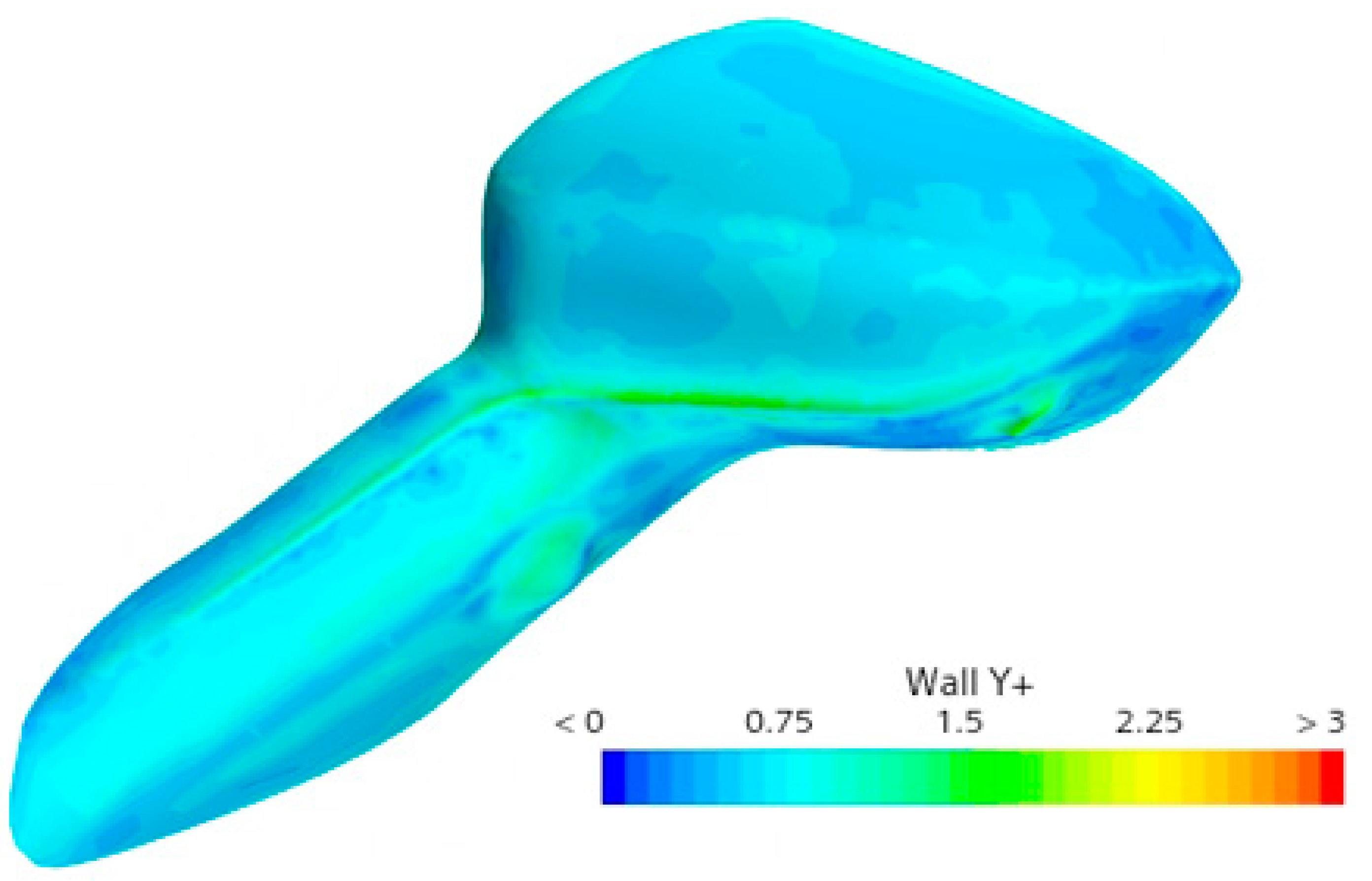
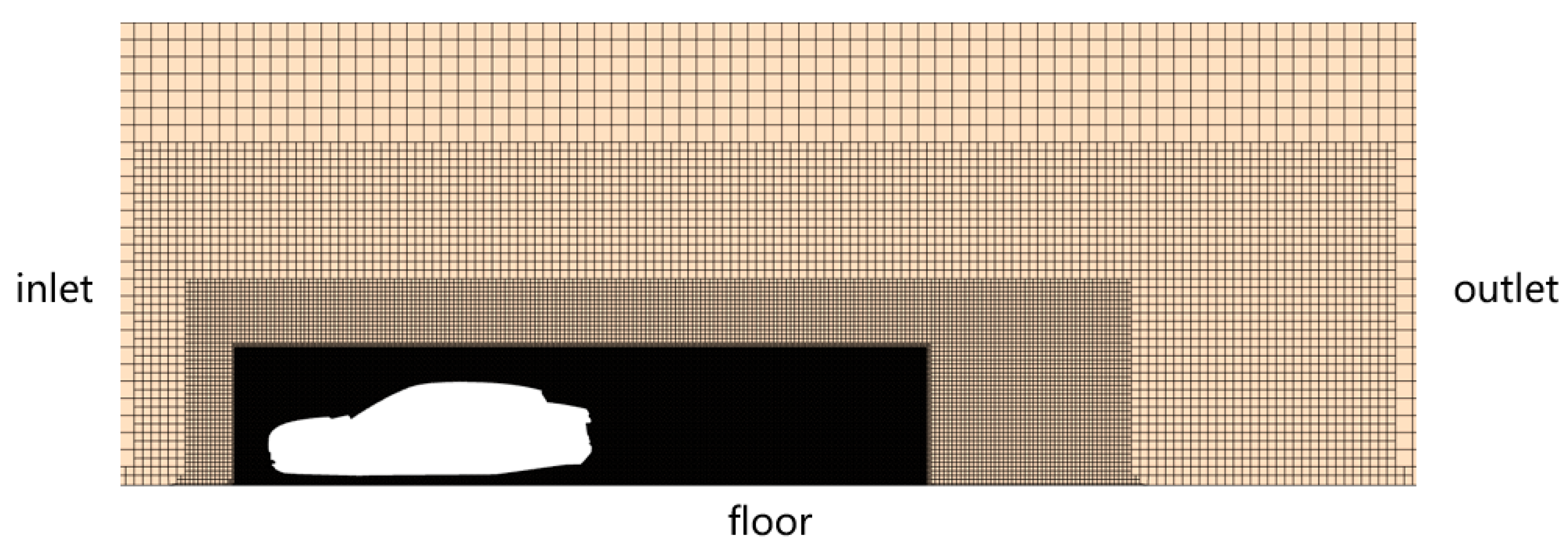
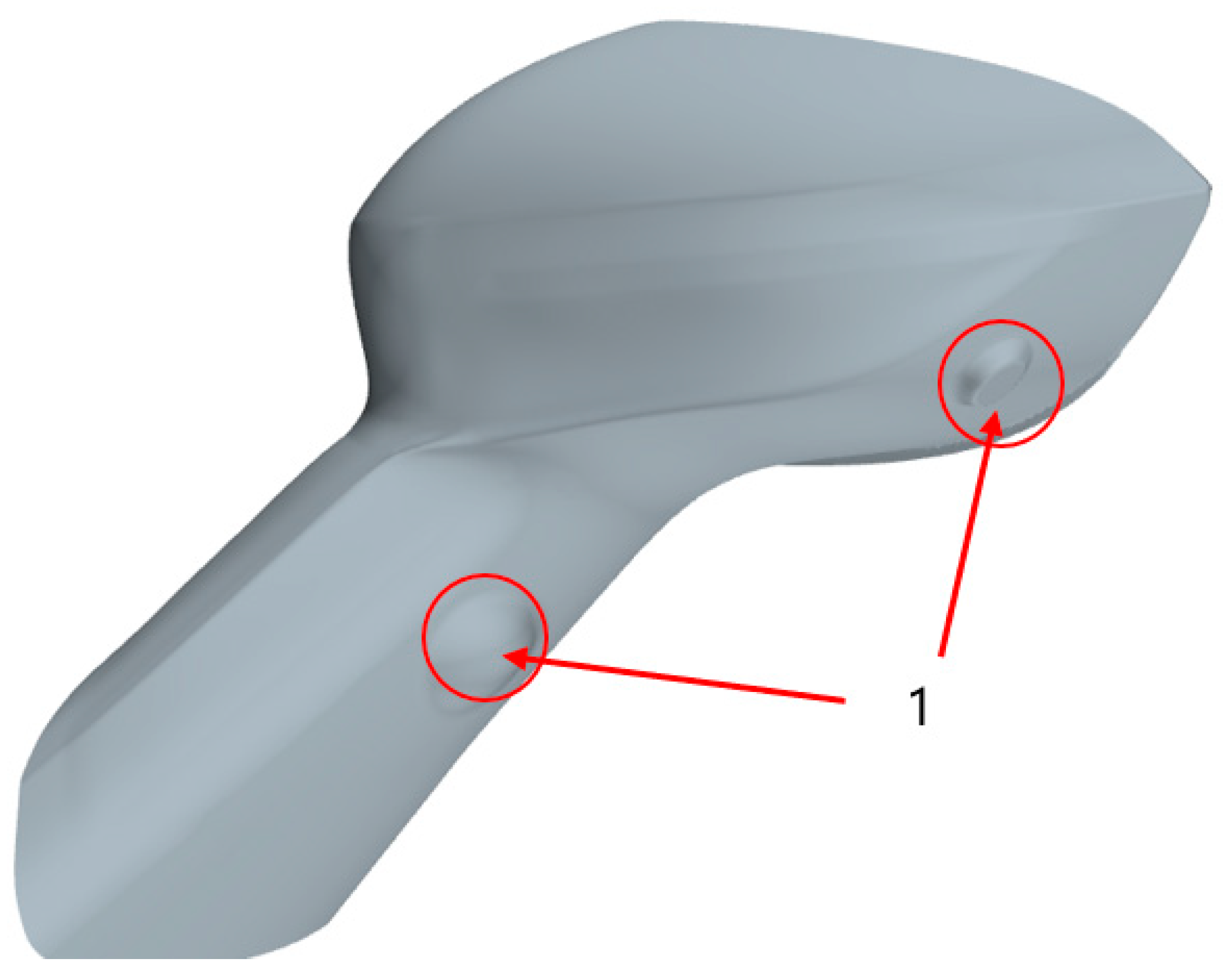
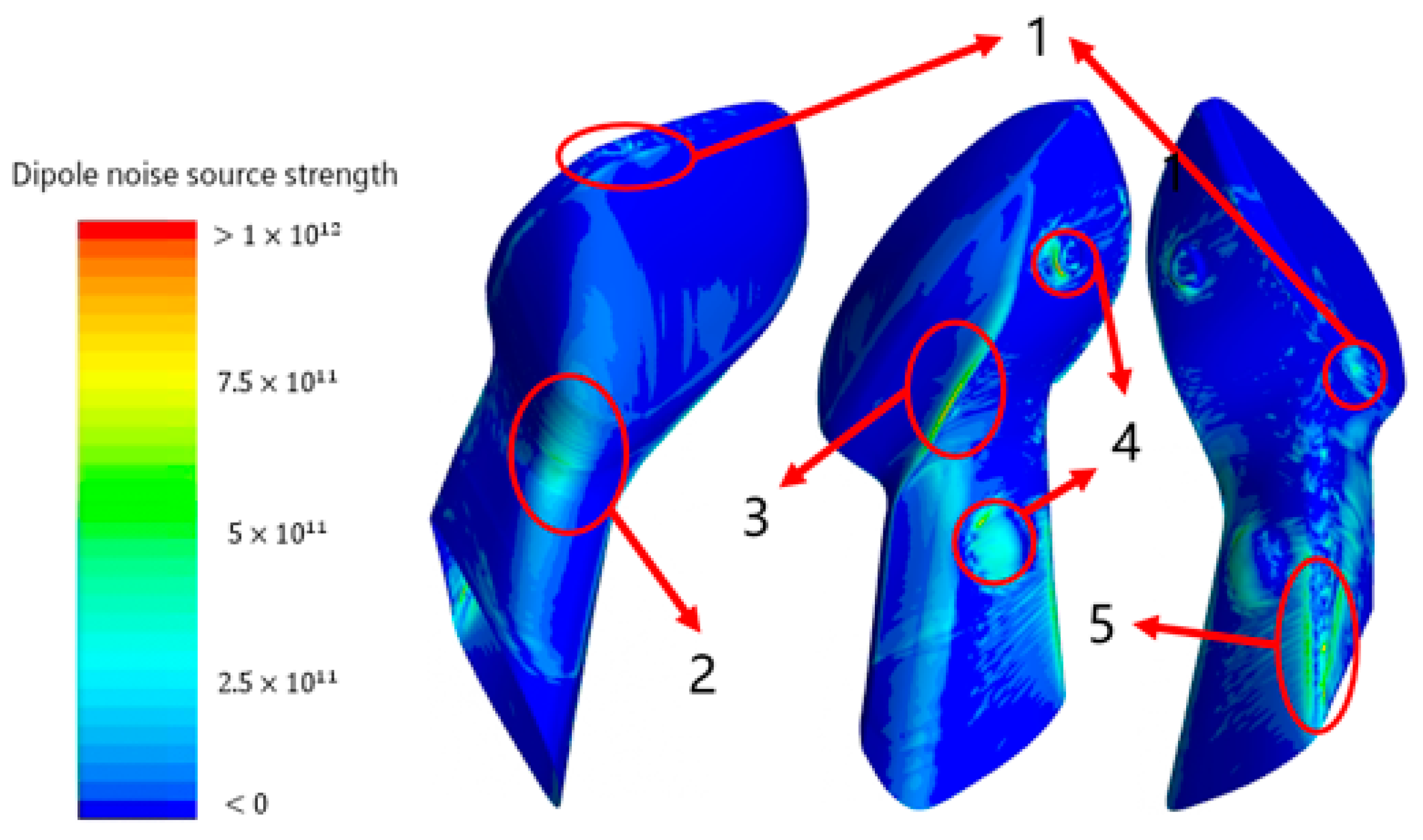
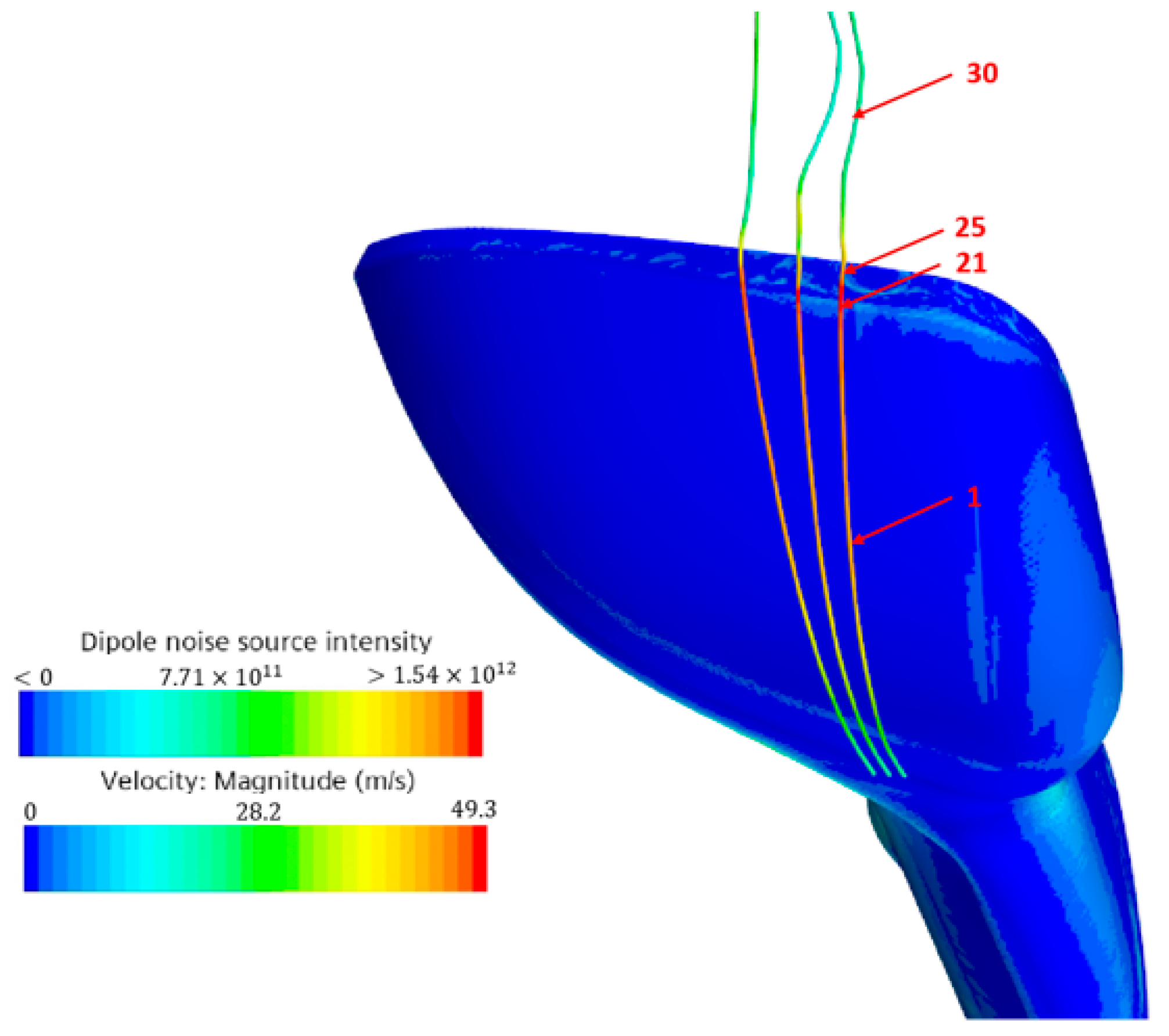

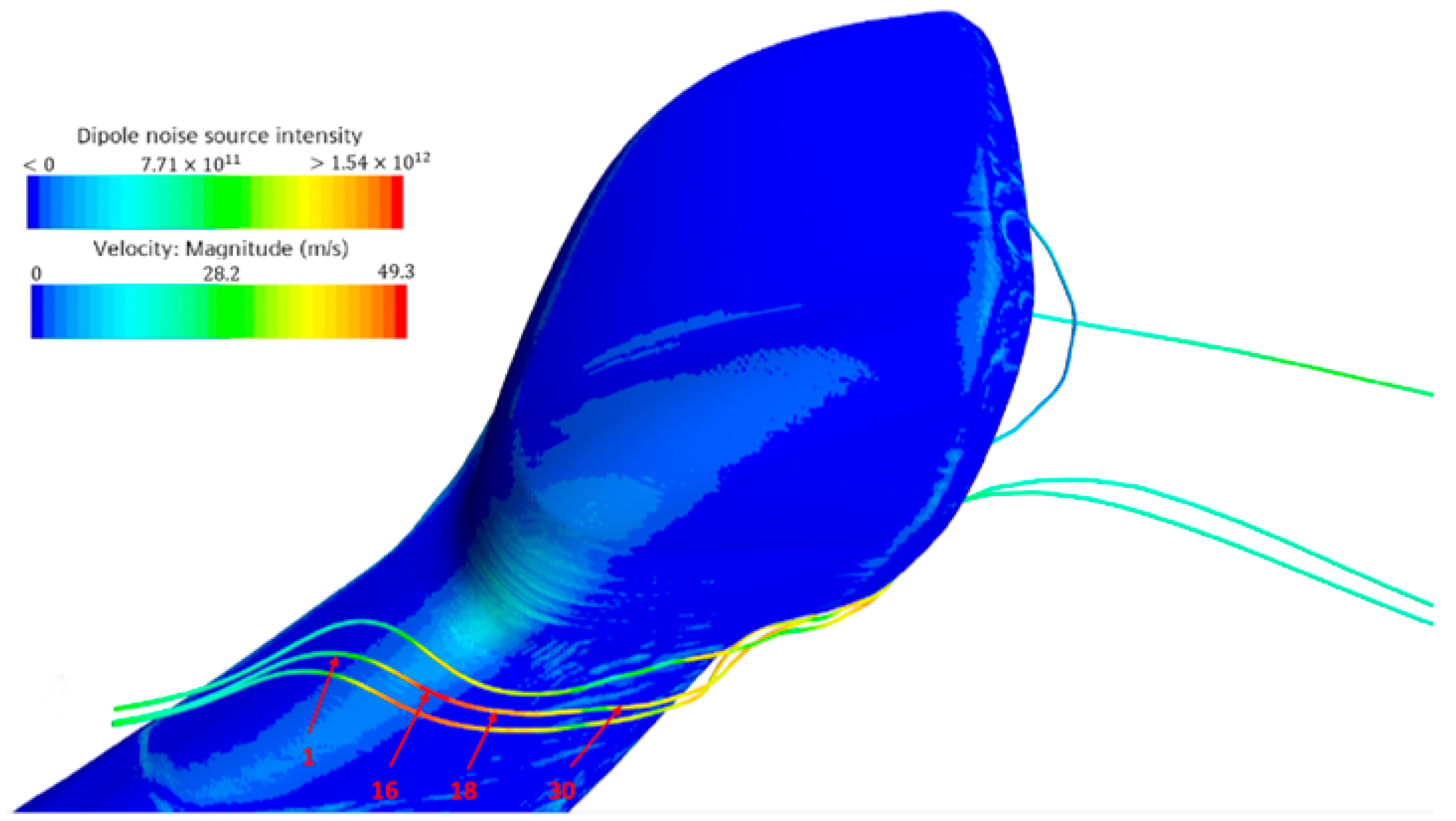
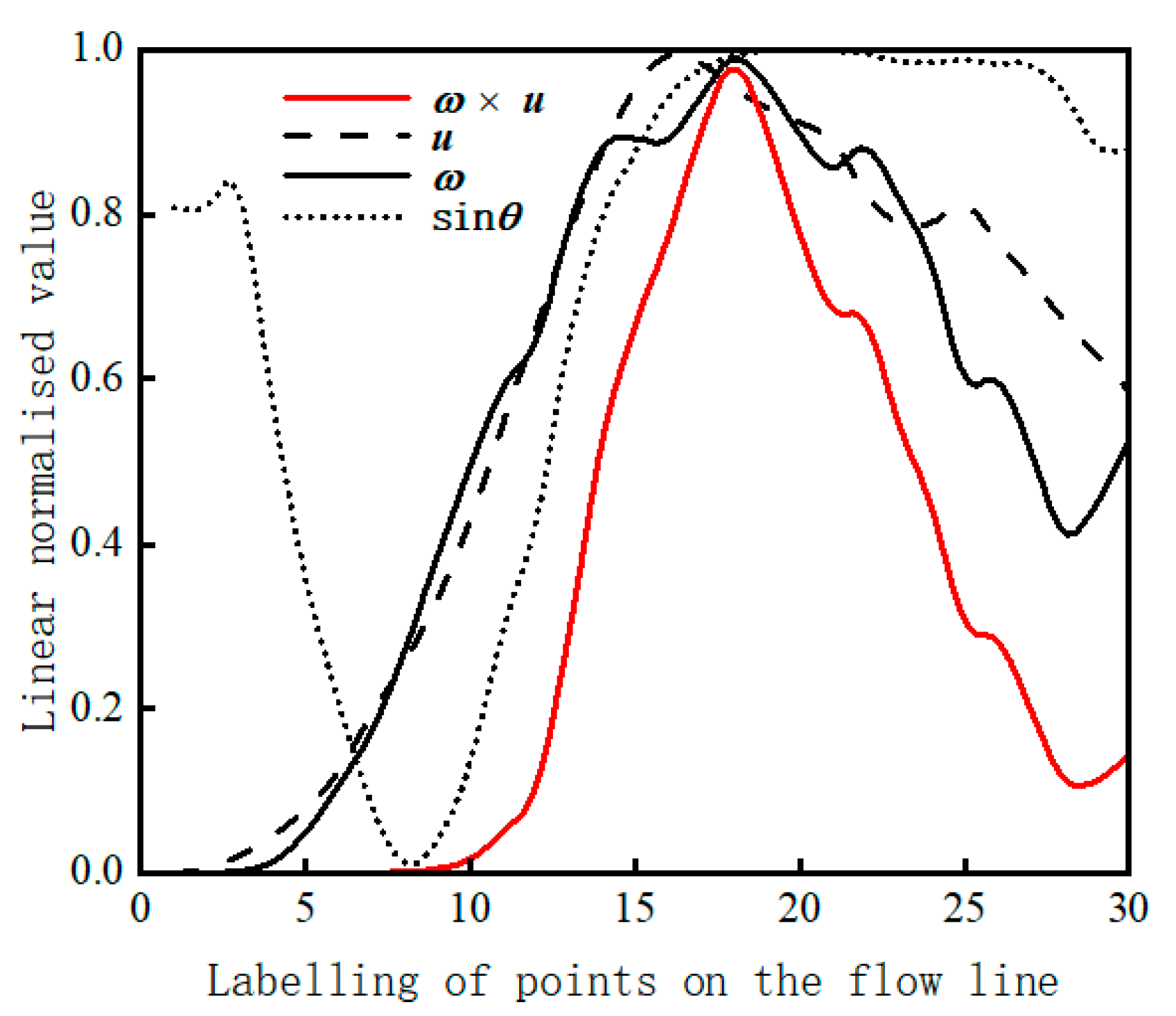
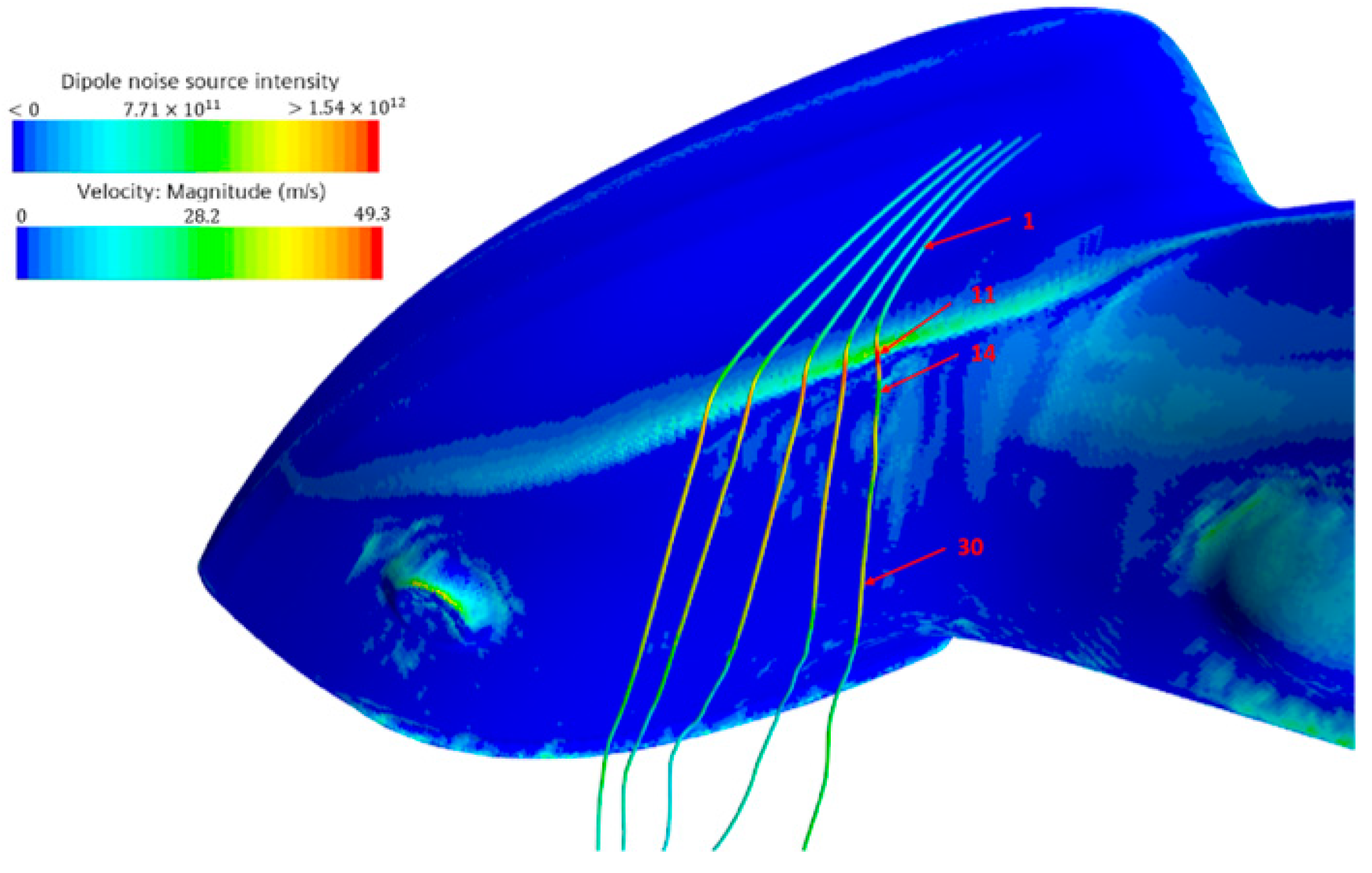

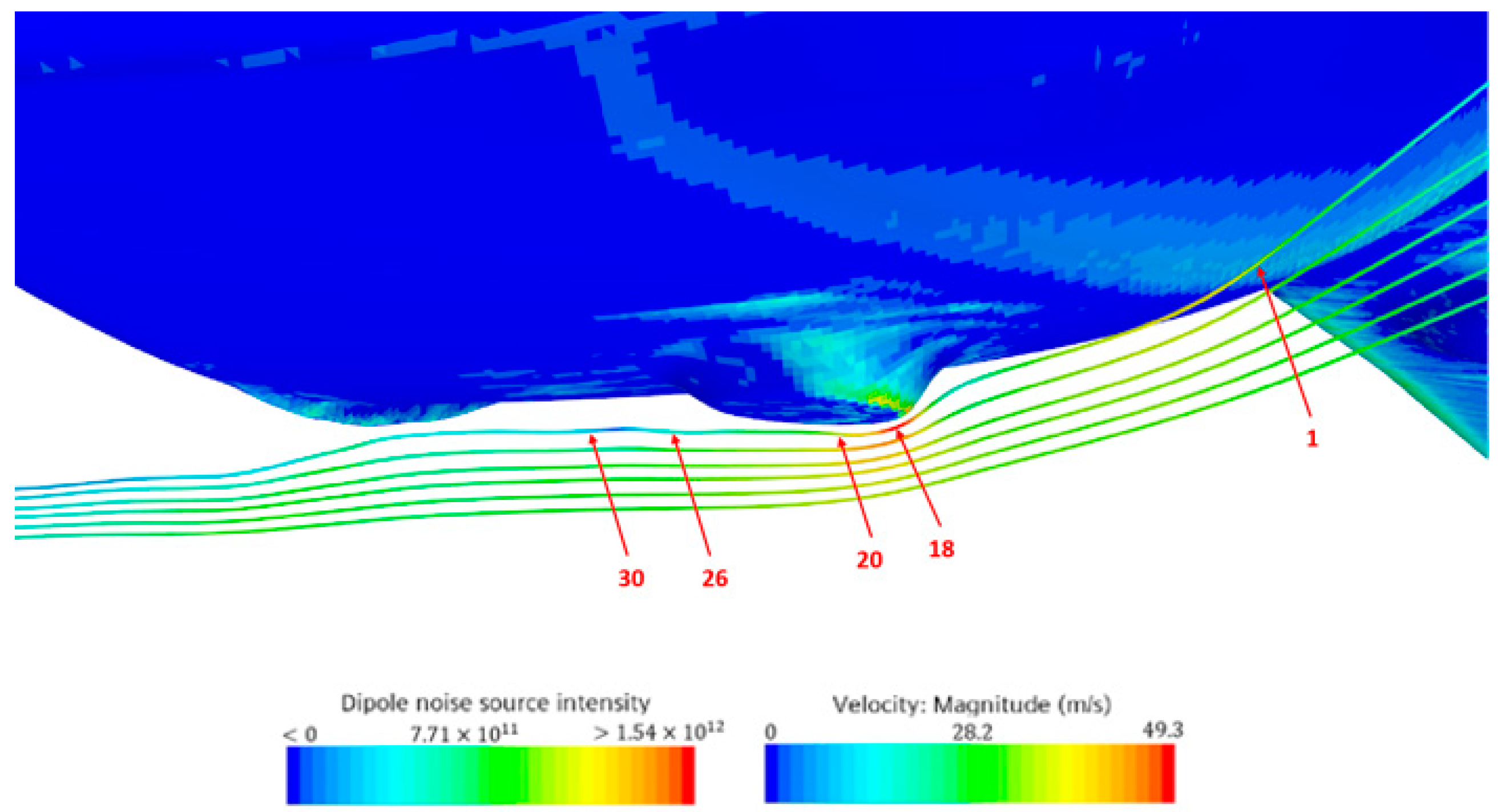
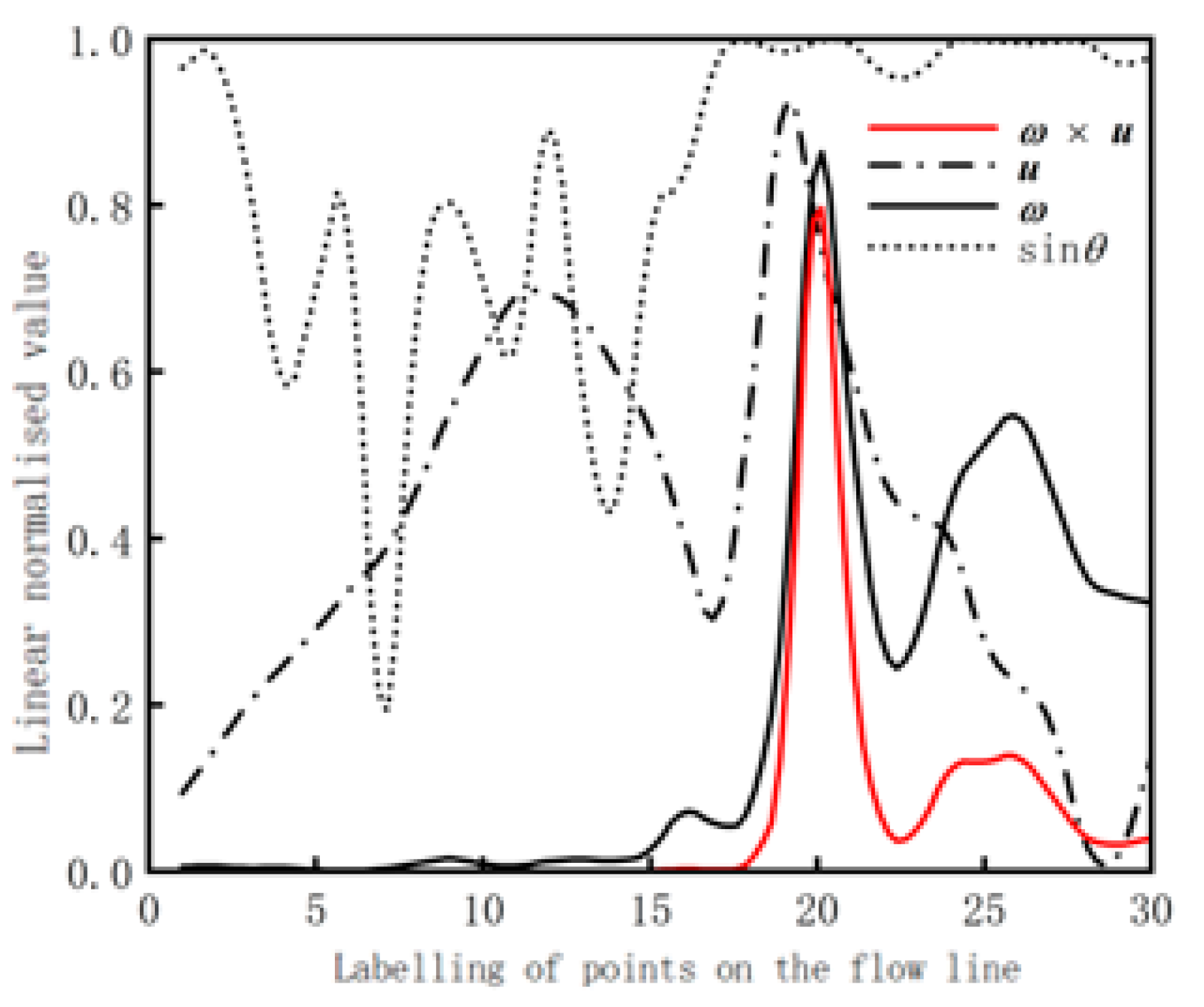
| Boundary | Boundary Condition |
|---|---|
| Inlet | Velocity inlet, u = 120 km/h |
| Outlet | Pressure outlet, p = 0 Pa |
| Calculate the top and side of the domain | Symmetrical wall |
| Others | Wall |
| Boundary | Boundary condition |
| Parameter | Option 1 | Option 2 | Option 3 | Option 4 | Option 5 |
|---|---|---|---|---|---|
| Number of grids | 15.6 million | 26.1 million | 32.4 million | 38.8 million | 45.6 million |
| Wind resistance coefficient (simulated value) | 0.352 | 0.332 | 0.314 | 0.315 | 0.315 |
| Wind resistance coefficient (test value) | 0.308 | ||||
Disclaimer/Publisher’s Note: The statements, opinions and data contained in all publications are solely those of the individual author(s) and contributor(s) and not of MDPI and/or the editor(s). MDPI and/or the editor(s) disclaim responsibility for any injury to people or property resulting from any ideas, methods, instructions or products referred to in the content. |
© 2023 by the authors. Licensee MDPI, Basel, Switzerland. This article is an open access article distributed under the terms and conditions of the Creative Commons Attribution (CC BY) license (https://creativecommons.org/licenses/by/4.0/).
Share and Cite
Zhang, S.; Pang, J.; Wang, Y.; Ma, R.; Jiang, H.; Jia, W.; Xu, X.; Xia, J. A Study of the Relationship between Dipole Noise Sources and the Flow Field Parameters around the Rearview Mirror of Passenger Cars. Appl. Sci. 2023, 13, 10651. https://doi.org/10.3390/app131910651
Zhang S, Pang J, Wang Y, Ma R, Jiang H, Jia W, Xu X, Xia J. A Study of the Relationship between Dipole Noise Sources and the Flow Field Parameters around the Rearview Mirror of Passenger Cars. Applied Sciences. 2023; 13(19):10651. https://doi.org/10.3390/app131910651
Chicago/Turabian StyleZhang, Siwen, Jian Pang, Yiping Wang, Rui Ma, Hao Jiang, Wenyu Jia, Xiaomin Xu, and Jinhao Xia. 2023. "A Study of the Relationship between Dipole Noise Sources and the Flow Field Parameters around the Rearview Mirror of Passenger Cars" Applied Sciences 13, no. 19: 10651. https://doi.org/10.3390/app131910651
APA StyleZhang, S., Pang, J., Wang, Y., Ma, R., Jiang, H., Jia, W., Xu, X., & Xia, J. (2023). A Study of the Relationship between Dipole Noise Sources and the Flow Field Parameters around the Rearview Mirror of Passenger Cars. Applied Sciences, 13(19), 10651. https://doi.org/10.3390/app131910651





